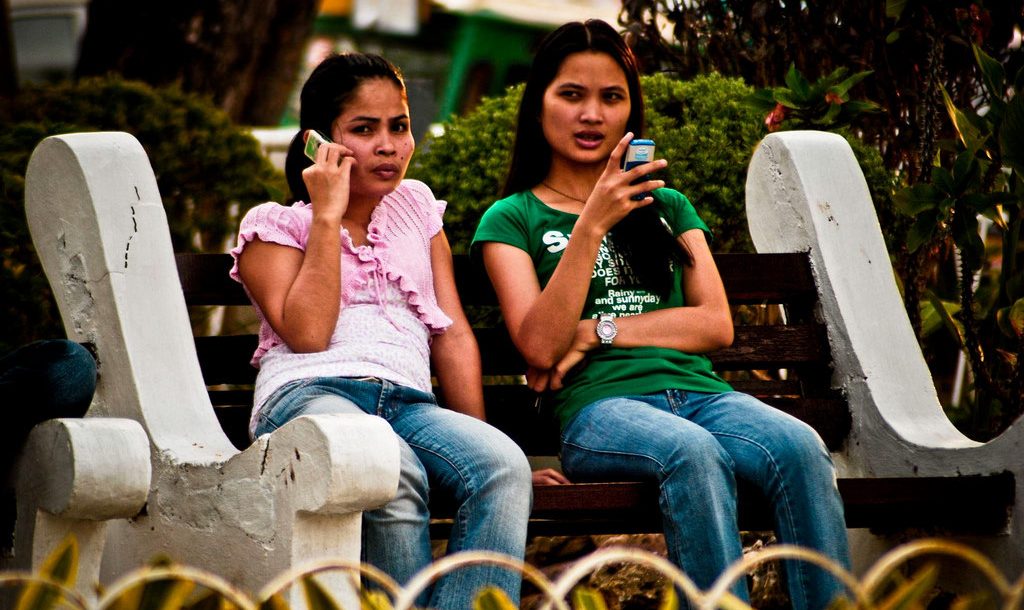Finding a romantic partner happens right at our fingertips. The proliferation of matchmaking websites and applications has revolutionised how intimate interracial relationships can be forged in a fast-paced and creative way.
However, such personalised and digital practices are not detached from the broader politics of gendered mobility, identity, and intimacy. In the Philippines, there are hidden contradictions surrounding Filipino women’s participation in the arena of networked matchmaking practices.
Gendered mobility
Even before the rise of dating applications, Filipinas had already used matchmaking channels to meet and eventually marry a foreign national.
Historically, interracial marriages had been linked to the phenomenon of mail-order brides. By definition, a mail-order bride is a woman who comes from a poor socioeconomic background and marries a foreign national for economic reasons. Philippine studies scholar Rolando Tolentino argues that the mail-order bride industry began as a product of interracial relations embodied by “hospitality girls” during the American colonial period.
From datus to trapos: reading Philippine history in the OED
How an English dictionary documents different eras of linguistic exchange between Filipinos and their colonisers.
A colonial past and a feminised overseas employment have contributed to the formation of interracial coupling in the Philippines.Per a report released by the Commission on Filipino Overseas, 477,025 of the 522,002 Filipinos who married foreign nationals between 1989 and 2016 were women. The top three countries where a Filipino spouse was married to a non-Filipino spouse are the United States (277, 511), Japan (122, 541), and Australia (40, 741).
Diverse yet homogenised
Online matchmaking channels have diversified over the past years through dating websites and mobile phone applications. A recent report suggests that internet dating has already become popular among Filipinos, including millennials.
Despite the boom in matchmaking platforms, the stereotypical representation of the Filipina persists. For example, Rosebrides, a mail-order website, capitalises on the characteristics of a Filipina—caring, family-oriented, committed, and English-speaking—as a “selling factor” for men who are in search of an ideal wife.
In Cherry Blossoms, an Asian dating website operating since 1974, a woman is portrayed as a young, pure and innocent individual. One could argue that the woman’s body is infantilised in these representations, which tends to reinforce the dominant position of the white man in the relationship.
Dating websites that specifically cater to Filipinos tend to complement how mail-order websites construct the identity of the Filipina as an ideal wife. Popular dating websites such as Filipino Cupid and Christian Filipina use visuals and narratives that feed the desires of a man who is looking for a long-lasting relationship. In Filipino Cupid, the image of Filipina is articulated as someone looking for friendship or a partner in life. The website also positions itself as a platform to “bring the Philippines to you.”
By analysing the language of the webpage, the Filipina and the Philippines are objectified. In Christian Filipina, the religious faith of a Filipina is highlighted, alluring men to attain what Tolentino coins “nuclear family fantasy”. Interestingly, while both platforms cater to men and women, much representation is given to women. This is evident in the content and the stream of “success stories” in the landing page of the websites.
By comparing and contrasting the matchmaking platforms, I argue that the portrayal of the Filipina’s identity reinforces not only patriarchal but also orientalist perspectives. The photographs, texts, promotional videos, and other elements of the websites construct an ideal femininity—nurturing, familial, God-fearing, and English-speaking—and perpetuate gender hierarchy.
One may then ask, what if one does not fit into certain tropes that are promoted by such dating channels?
Agency in mediated intimacy
Filipinas utilise dating platforms in many possible ways. Diverse practices reflect how agency is performed. For instance, Filipinas use dating platforms alongside social media channels to communicate with and build trust among their potential foreign partner. These practices complement the findings of an ethnographic study of Nicole Constable on how Chinese and Filipino women managed their relationships with their foreign husband. Some women set the conversations, decision-making and outcomes of activities.
More recently, a Filipina’s agency in an interracial relationship is rendered visible on YouTube. Filipina singles and their non-Filipino partner have been proactive in curating and broadcasting their most intimate moments online.
For example, Rhaze, a Filipina YouTuber in Australia with over 480,000 subscribers, shared her journey in meeting her Australian husband through a dating website on YouTube. In some cases, interracial couples showcase their mundane interactions, travels, culinary adventures, social networking, and even playfulness by completing challenges.
Significantly, these videos contribute to the construction of femininity—a caring, domesticated and committed wife and mother. Notably, visuals also feed the imaginaries of the viewers on the “good” and “fun” life. However, the display of affective online may receive negative remarks from commenters.
The contradictions
Matchmaking channels and networked platforms have reconfigured the Filipino women’s agency in matchmaking processes and outcomes. Interactions with a potential partner are facilitated through multiple platforms. And in some cases, a YouTuber challenges tropes of femininity such as submission and victimhood.
Paradoxically, these mediated practices of the Filipina underpin the operations of a neoliberal economy. The limited, or lack thereof, support by nation-state to its citizens compels individuals to deploy tactics for survival. Intimate relationships can be viewed as commercial goods bought and sold over the internet. These platforms also tend to encourage women to exercise constant surveillance, policing and makeover of oneself to be palatable to a patriarchal and commercial market, as well as a postcolonial public.
Meanwhile, corporations as well as the national economy benefit from such mediated and transnational routines through the circulation of remittances and care packages. Nevertheless, intimate, transnational and digital spaces may reinforce the systems that disempower and exploit women.
In celebration of the International Women’s day, let us further re-examine how we perceive and position the Filipino woman in a networked and global society. It is through such critical reflections that we may develop ideas, frameworks and approaches in further advancing the rights of Filipino women in thriving in an equitable society.
 Facebook
Facebook  Twitter
Twitter  Soundcloud
Soundcloud  Youtube
Youtube  Rss
Rss 



